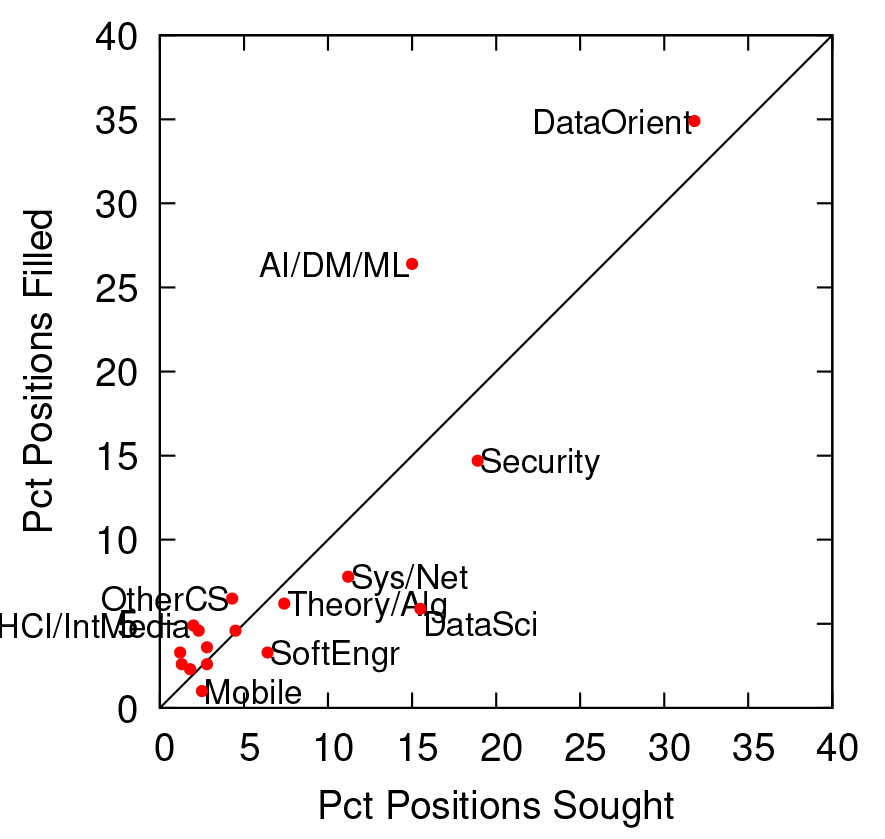Outcomes of Advertised Computer Science Faculty Searches for 2022
This work directly follows previous work that analyzed current and future Computer Science needs via advertised tenure-track faculty searches for 2022. This follow-on work looked to understand the relative success of institutions in hiring the tenured/tenure-track faculty in the areas of Computer Science that were being sought. This work also follows on a similar study of tenure-track faculty hiring outcomes last done in the pre-Covid impacted year of 2019.
Responses to a survey were obtained from 148 institutions that reported seeking tenure-track faculty in 2022. The distribution of survey responses based on institutional type was in roughly the same proportion as for all institutions that were searching for tenure-track faculty. Survey respondents reported seeking a total of 379 faculty positions.
Survey respondents reported filling a total of 289 tenure-track faculty for an aggregate success rate of 76%, which is comparable to the 2019 study. Examination on the success of the search for each of the 148 institutions found that 21% of institutions failed to hire any faculty, while 55% succeeded in hiring at least as many faculty as were being sought. These failed search results are worse than, and the institutional success results are comparable to, survey results from 2019. In terms of results for different types of institutions, PhD institutions reported failed search rates of only a few percent and at least successful searches for more than 60% of institutions. In contrast, BS/BA (37%) and MS (29%) institutions reported a much higher percentage of failed searches. There was also a lower percentage of successful searches with 38% for MS and 54% for BS/BA institutions.

Reported results on the previous position for hired faculty show that three types of such positions continue to be most prevalent. 31% of hired faculty start with a newly-earned PhD, 24% were previously in a tenured or tenure-track position at another institution, and 23% were previously in a post-doc/researcher position. The newly-earned PhD results are higher than results from a similar study in 2019 and the post-doc results are lower indicating more hires of new faculty with less experience.
Survey respondents reported on the number of hires in each of 16 clustered areas. The clustered area of AI, Data Mining and Machine Learning (AI/DM/ML) accounted for 26% of the filled positions (comparable to 2019). Security accounted for the next most with 15% of the filled positions (similar to 15% in 2019) while Systems/Networking (8%), Theory/Algorithms (6%) and Data Science (6%) were the next areas in terms of filled positions. Further clustering of results for the AI/DM/ML, Databases and Data Sciences areas finds that 35% of hires were “Data Oriented,” which is up from 33% in 2019.

In comparing the areas of filled positions with the areas in which positions were sought, the AI/DM/ML area shows the biggest net positive difference percentage of positions filled and sought. In contrast, the area of Security showed similar (compared with 2019) negative difference with 15% of filled positions, but 19% of sought positions. The area of DataSci had a 10% negative net percentage difference between filled and sought positions. Data-oriented areas accounted for 32% of sought positions and 35% of filled positions.
A final analysis uses Taulbee Survey results to compare areas for PhD production with area of faculty positions sought and filled. Security is the area with most obvious discrepancy between percentage of PhDs produced (6%) and faculty positions sought (19%). Security is the area with the highest discrepancy between PhDs produced and positions filled with a net of 9% more positions filled than PhDs produced.
View the full report at: https://web.cs.wpi.edu/~cew/papers/outcomes22.pdf









